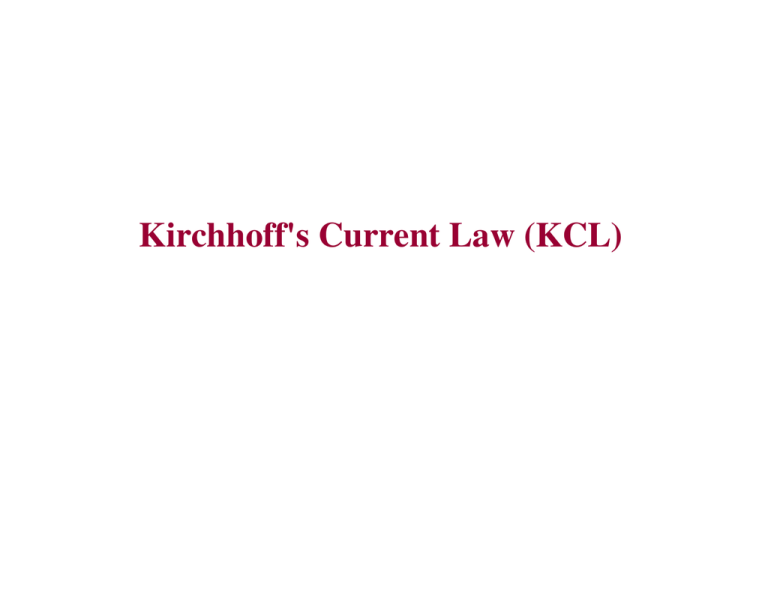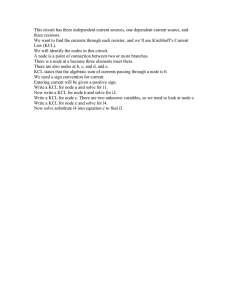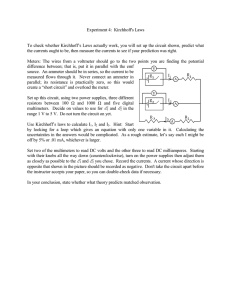Kirchhoff`s Current Law (KCL)
advertisement

Kirchhoff's Current Law (KCL) I. Charge (current flow) conservation law (the Kirchhoff’s Current law) 2 e p Pi Pipe 1 Pip e3 Total volume of water per second flowing through pipe 1 = total volume of water per second flowing through pipe 2 + total volume of water per second flowing through pipe 3 I. Charge (current flow) conservation law (the Kirchhoff’s Current law) I2 I1 I3 Total current (charge per second) entering the node through the wire 1 = total current leaving the node through the wire 2 total current leaving the node through the wire 3 + Kirchhoff's Current Law (KCL) "The algebraic sum of all currents entering and leaving a node must equal zero" Σ (Entering Currents) = Σ (Leaving Currents) ( ( Established in 1847 by Gustav R. Kirchhoff KCL Example 1 I0 =10 mA I2 =? R2 I1= 4 mA The rest of the circuit V0 R1 Entering current: I0 Leaving currents: I1, I2 I0 = I1 + I2; I2 = I0 – I1; I2 =10 mA – 4 mA = 6 mA KCL Example 2 A I0 B I1 I3 I2 I1= 2 mA Network fragment I4 I3= 0.5 mA I2 = 5 mA Considering node A: I0 = ? I0 = I1+I2 = 7 mA Considering node B: I4 = ? I4 = I1- I3 = 2 mA – 0.5 mA = 1.5 mA • KCL can be applied to any single node of the network. • KCL is valid for any circuit component: diode, resistor, transistor etc. Problem 1 R1 R2 R3 IC1 I0 R4 IC2 T1 T2 I0 = 20 mA IC1 = 4 mA; IC2 = 3 mA; IC3 = 2 mA IC3 I4 T3 Find the current I4 in mA 0 of 40 180 Timed response Circuits with multiple sources + + VB1 VB2 - - In circuits with more than one source, the current directions are not obvious up front. + VB1 + VB2 - - + + VB1 - VB2 - The actual current directions depend on the potential profile in the circuit. ϕ1 = 8 V; 12V ϕ2 = 4.5 V; 6V Suppose the potentials are known. Then the current directions are as shown. (Of course, knowing the potentials requires solving the circuit!) For different potential distribution, the current directions could be different: ϕ1 = 7 V; 6V ϕ2 = 9 V; 12V Suppose the potentials are known. Then the current directions are as shown. (Of course, knowing the potentials requires solving the circuit!) The actual current direction depends on the potential difference across the component ϕ1 = 7 V 1 2 R=1k V12 = ϕ1 – ϕ2 ϕ2 = 2 V I V ϕ −ϕ I12 = 12 = 1 2 R R If ϕ1 > ϕ2, the current 5 mA flows from the node #1 to the node #2 The actual current direction depends on the potential difference across the component ϕ1 = 7 V 1 ϕ2 = 12 V 2 R=1k V21 = ϕ2 – ϕ1 V21 ϕ2 − ϕ1 12V − 7V I 21 = = = = 5mA R R 1k +5 mA If ϕ1 < ϕ2, the actual current 5 mA flows from node #2 to node #1 We can also say that, the current defined as flowing from node#1 to node# 2 is negative in this case. V12 = ϕ1 – ϕ2 V12 ϕ1 − ϕ2 7V −12V I12 = = = = − 5mA < 0 1k R R - 5 mA General form of KCL Σ (Entering) = Σ (Leaving) ( ( Σ (Entering) - Σ (Leaving) =0 ( ( Assigning positive signs to the currents entering the node and negative signs to the currents leaving the node, the KCL can be re-formulated as: Σ (All currents at the node) = 0 ( Problem 2 I2 I1 = 1 A I1 I2 = 3 A I4 I3 I3 = 0.5 A Find the current I4 in A 0 of 40 120 Timed response Problem 2 I2 I1 = 4 A I1 I2 = 3 A I3 = 0.5 A I4 I3 Find the current I4 in A 0 of 40 120 Timed response Parallel Circuits The defining characteristic of a parallel circuit is that all components are connected between the same two wires (ideal conductors). In a parallel circuit, the voltages across all the components are the same, no matter how many components are connected. There could be many paths for currents to flow. Simple parallel circuits E= The voltage drops are equal across all the components in the circuit. Why? V12 = V23 = V34 =0 (voltage drops across the wires = 0) φ1 = φ2 = φ3 = φ4 = E; Similarly, φ5 = φ6 = φ7 = φ8 = 0 ; From these: V27 = V36= V45 = E; Currents in the parallel circuits E= Using the Ohm’s law: I1 = V27/R1 = E/R1 I2 = V36/R2 = E/R2 I3 = V45/R3 = E/R3 Currents in the parallel circuits What is the total current in the circuit? IT I1 I2 I3 E= Now apply the KCL, SUM (Currents) = 0 IT – I1 – I2 – I3 = 0; IT = I1 + I2 + I3 = E/R1+ E/R2+ E/R3 = E×(1/R1+ 1/R2+ 1/R3) Currents in the parallel circuits IT I1 I2 E= I1 = V27/R1 = E/R1 = 9V/10kΩ = 0.9 mA I2 = V36/R2 = E/R2 = 9V/2kΩ = 4.5 mA I3 = V45/R3 = E/R3 = 9V/1kΩ = 9 mA IT = 0.9 + 4.5+ 9 = 14.4 mA I3 Equivalent resistance for parallel circuits IT I1 I2 I3 REQ E= IT = I1 + I2 + I3; IT = E×(1/R1+ 1/R2+ 1/R3) Let us replace the part of network containing R1, R2 and R3 with a single resistor RT. Then IT = E/REQ (the Ohm’s law) If some resistors in the network or a part of it, are connected in parallel, then the equivalent resistance is: 1/REQP = 1/R1 + 1/R2+1/R3 Equivalent resistance for parallel circuits IT I1 I2 I3 E= 1/REQP = 1/R1 + 1/R2+1/R3 Note: G = 1 / R; GT = G1 + G2 + G3 Another formulation of the parallel connection rule: the equivalent conductance = sum (all the parallel conductances) When the circuit contains only two parallel resistors: The equivalent resistance 1/REQ = 1/R1 + 1/R2 1 REQ = REQ = 1 1 R1 + R2 + = R1 R2 R1 R2 R1 R2 R1 + R2 Current division in a parallel circuit E E I1 = R1 I2 = E R2 I1 R2 = I 2 R1 I1 G1 = I 2 G2



